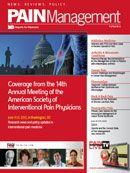Overlap between Myofascial Pain Syndrome and Fibromyalgia, and the New Thinking on the Role of Myofascial Trigger Points
Myofascial pain syndrome and fibromyalgia are common forms of musculoskeletal pain that are often confused with each other, not only because of similar symptoms, but also because they frequently occur in the same patient, which can lead to difficulties in differential diagnosis and treatment.
Myofascial pain syndrome and fibromyalgia are common forms of musculoskeletal pain that are often confused with each other, not only because of similar symptoms, but also because they frequently occur in the same patient, which can lead to difficulties in differential diagnosis and treatment.
Fibromyalgia was previously diagnosed using the 1990 American College of Rheumatology (ACR) criteria (http://1.usa.gov/KRiJWi), which required that physicians perform a Tender Point Test, a physical exam that focuses on 18 specified tender points throughout the body. A diagnosis was made when pain had been present in all four quadrants of the body for over three months’ duration and at least 11 of these 18 points elicited pain upon digital palpation. The 1990 ACR criteria did not take into account any symptoms other than pain. In 2010, a preliminary new set of ACR criteria were published in Arthritis Care & Research (http://bit.ly/KRLXEr), in which the Tender Point Test had been replaced by an assessment of pain (ie, the number of painful areas from a checklist of 19 specified areas) and severity of other symptoms (including fatigue, waking unrefreshed, and cognitive problems) over the past week. One reason that patients with fibromyalgia experience a number of symptoms other than pain was suggested by a study by Geisser and colleagues (http://1.usa.gov/KRM2b8) that found that fibromyalgia is associated with central sensitization.
Unlike fibromyalgia pain, the pain in myofascial pain syndrome is more localized or regional (along the muscle and surrounding fascia tissues) and is associated with localized small hypersensitive nodules (ie, taut bands), known as myofascial trigger points.
Over the years, attempts have been made in the literature to differentiate between the tender points associated with fibromyalgia (http://1.usa.gov/NprJ62) and the trigger points associated with myofascial pain syndrome (http://1.usa.gov/M7MrHW). However, many researchers use the terms interchangeably, and many patients have both tender and trigger points, causing confusion and complicating diagnosis. “I have long maintained that tender points and trigger points are one and the same,” says Robert M. Bennett, MD, professor of medicine and nursing at Oregon Health and Science University.
Results of a study published by Ge and colleagues (http://1.usa.gov/LTDmTs) suggest that fibromyalgia pain may be due in large part to active (vs. latent) myofascial trigger points. In this study, 30 patients with fibromyalgia and 30 healthy age- and gender-matched controls were asked to draw all areas of their current spontaneous pain on an anatomical map and rate the overall intensity of their pain. The location of all active trigger points was then determined in the fibromyalgia patients using manual palpation. A total of 308 active trigger points were found in the 30 patients with fibromyalgia, and 305 of these were confirmed by spontaneous electrical activity demonstrated on needle electromyography. The locations of these 308 active myofascial trigger points were then mirrored onto the 30 healthy controls as an aid to identifying latent trigger points, and spontaneous electrical activity was found in 304 of these latent points. The authors concluded that most of the tender point sites were trigger points, with local and referred pain from active trigger points partly reproducing the overall spontaneous pain pattern. The total number of active trigger points was positively correlated with the spontaneous fibromyalgia pain intensity. This study provided evidence of the importance of active trigger points, which may serve as peripheral generators of fibromyalgia pain, and the authors suggested that inactivation of active trigger points may be an alternative for the treatment of fibromyalgia.
The findings of Ge and colleagues have been replicated by Alonso-Blanco and colleagues (http://1.usa.gov/KEvy87), who also found that widespread pain hypersensitivity in fibromyalgia patients was related to increased numbers of active myofascial trigger points.
In a 2011 editorial (http://1.usa.gov/Kn05Zo), Bennett described the technique for distinguishing between active trigger points (which are found in patients with fibromyalgia) and latent trigger points (which are found in healthy individuals). “Gentle palpation should be performed across the direction of the muscle fibers in order to identify a region of tenderness and nodularity (that is, the taut band). Continued firm palpation of a myofascial trigger point for at least 5 seconds is required to elicit the typical distribution of referred pain. An active myofascial trigger point is deduced if firm pressure over the taut band reproduces the patient’s spontaneous pain symptoms. If the pain symptoms are not reproduced, the tender area is designated a latent trigger point.”
